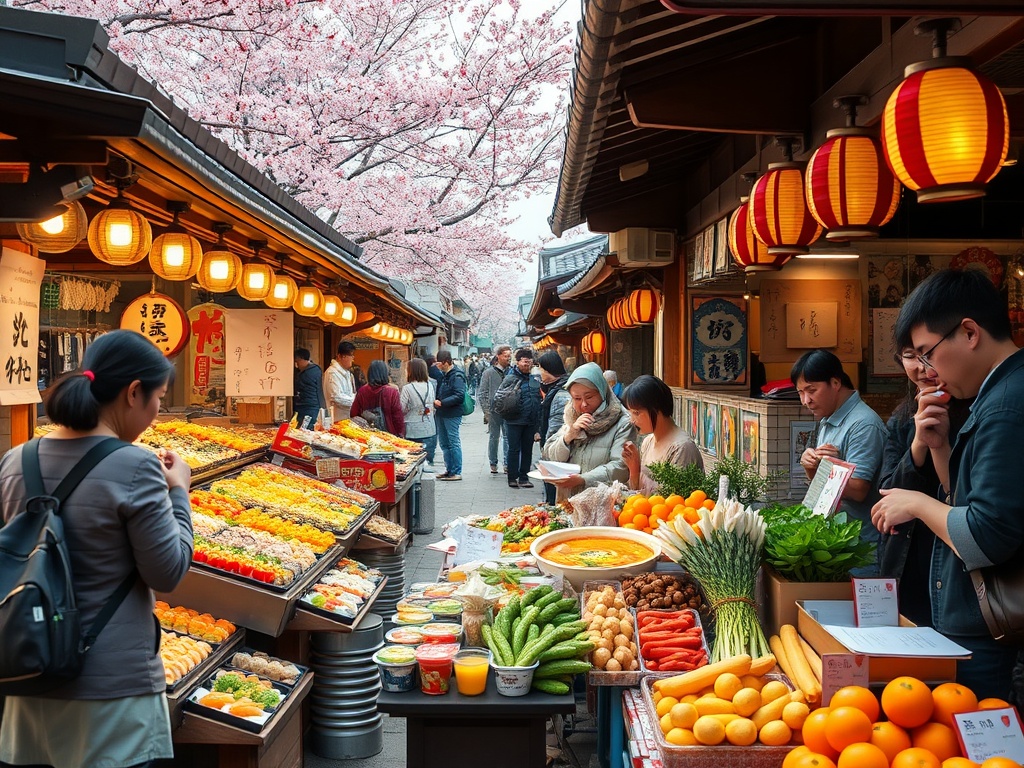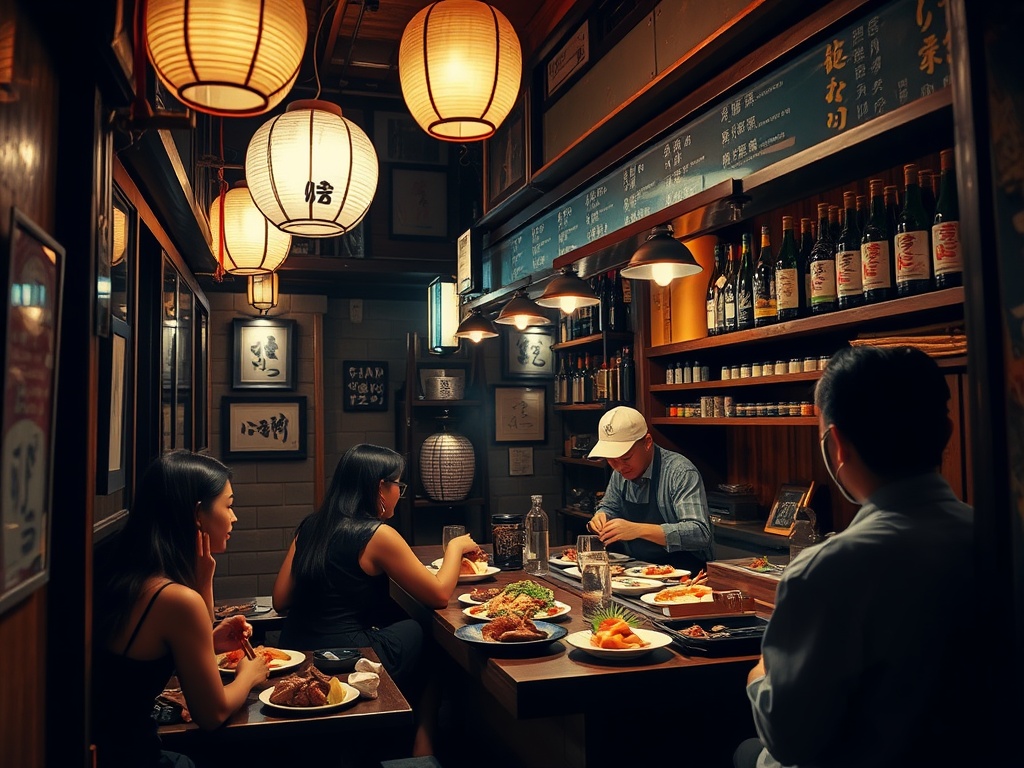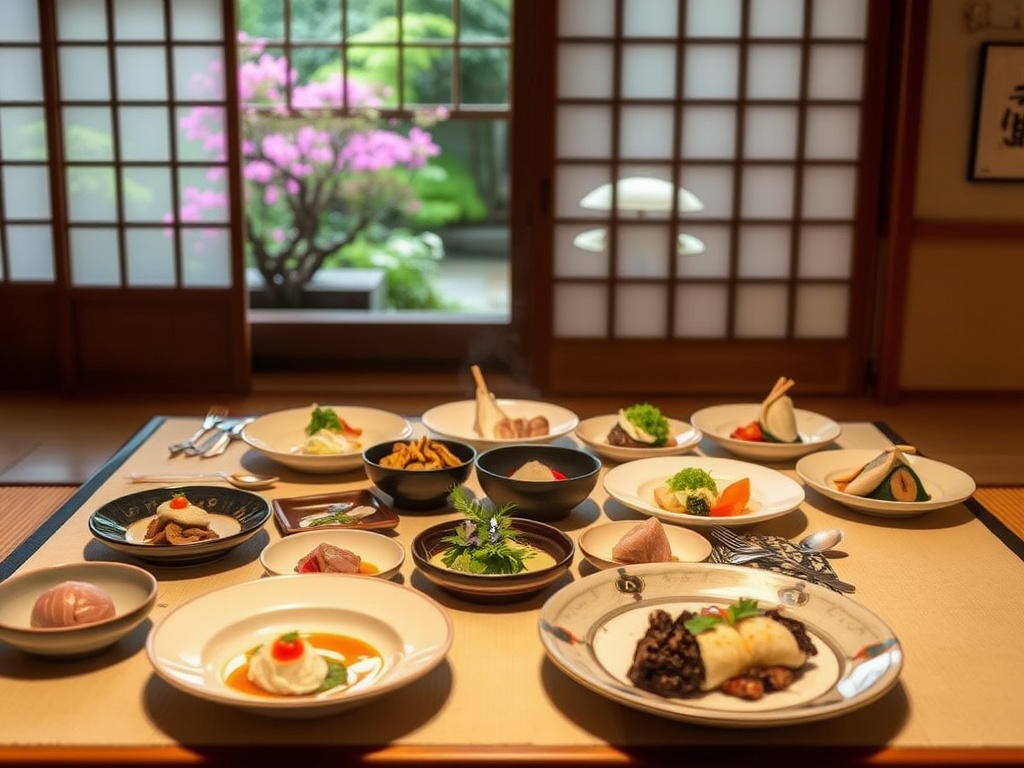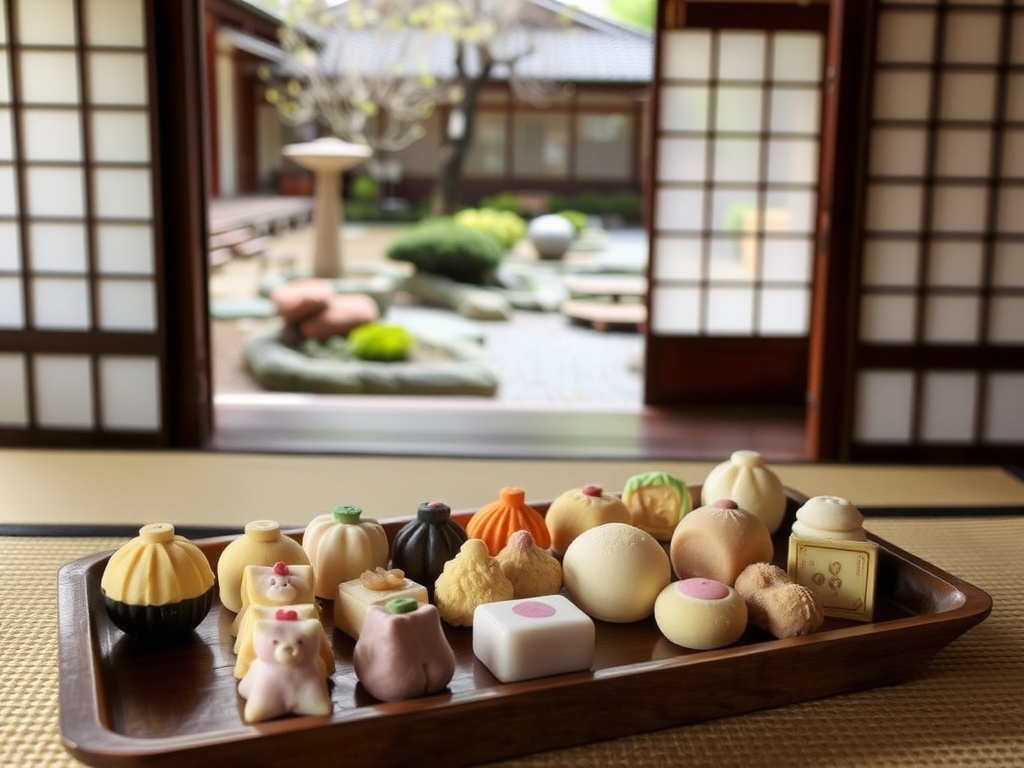Savor the Secrets of Kyoto’s Hidden Izakayas
Win a Free Trip to Japan!
Experience cherry blossoms and ancient temples
Embark on a tantalizing journey through Kyoto’s labyrinth of lantern-lit alleyways, where the best-kept culinary secrets lie waiting to be discovered. This ancient city, known for its majestic temples and serene gardens, also boasts a vibrant food scene hidden in plain sight. Let’s dive into the clandestine world of Kyoto’s izakayas, the cozy Japanese pubs that serve up delectable delights and local brews.
Kyoto’s izakayas are a testament to the city’s rich history and cultural fusion. Unlike the bustling bars of Tokyo, Kyoto’s izakayas offer an intimate setting where you can savor traditional dishes with a modern twist. The atmosphere is warm, often adorned with wooden interiors and low lighting, inviting patrons to unwind and indulge.
Oftentimes, these hidden gems are tucked away in nondescript buildings, behind noren curtains, or down narrow alleyways, making the hunt part of the adventure. Once inside, you’ll find yourself in a world of culinary wonder, surrounded by locals who know where to find the city’s best-kept secrets.
While every izakaya has its specialties, there are certain dishes that stand out and are a must-try for any visitor. Each dish tells a story of Kyoto’s culinary heritage, infused with the creativity of its chefs.
- Kushiage: Skewered and deep-fried morsels of meat and vegetables, offering a delightful crunch with every bite.
- Yudofu: Simple yet comforting, this hot tofu dish is a staple of Kyoto’s Buddhist cuisine.
- Kyoyasai: Seasonal Kyoto vegetables prepared in various styles, showcasing the region’s agricultural bounty.
No izakaya experience is complete without sampling the local beverages. From sake brewed in the surrounding regions to house-specialty cocktails infused with green tea or yuzu, each sip is a tribute to Kyoto’s dedication to craftmanship.
For those adventurous enough to explore these hidden izakayas, the reward is a feast for both the palate and the soul. As you savor these culinary treasures, you’ll find that the true flavor of Kyoto is not just in the food, but in the stories and traditions that each dish carries.
Discover the Art of Kaiseki: A Culinary Journey Through Time
Delve into the exquisite world of Kaiseki, a traditional multi-course Japanese dinner that is as much about the artistry as it is about the flavors. This dining experience is a journey through time, rooted deeply in the customs and aesthetics of Kyoto. Each meal is a carefully crafted narrative, reflecting the seasons and the chef’s philosophy.
In the intimate confines of a Kyoto restaurant, you’ll find yourself surrounded by an ambiance that echoes the elegance of the city’s cultural heritage. The meticulous presentation of each course is akin to a theatrical performance, where every dish is a masterpiece designed to evoke a sense of harmony between nature and cuisine.
At the heart of Kaiseki lies the commitment to balance and seasonal freshness. Each course, from the delicate sashimi to the subtly flavored broths, is a celebration of the natural ingredients at hand. Chefs take pride in their craftsmanship, ensuring that every bite is a symphony of textures and flavors. The progression of dishes is thoughtfully orchestrated, guiding your palate through a journey that is both satisfying and enlightening.
The experience of Kaiseki is not just about dining; it’s a form of meditation, where the art of eating is elevated to a spiritual level. As you savor each course, you are not just tasting food but absorbing the essence of Kyoto’s rich culinary tapestry.
Kaiseki is more than just a meal; it is a cultural ritual that has been perfected over centuries. Originating from the Japanese tea ceremony, it represents a synthesis of hospitality and gastronomy. The precision with which each dish is prepared and presented is a testament to the dedication of the chefs who strive to preserve Kyoto’s age-old traditions.
To partake in a Kaiseki meal is to step into the shoes of Japan’s ancient nobility, who once enjoyed these elaborate feasts. It’s a chance to connect with the past and appreciate the profound respect for nature and seasonality that defines Japanese cuisine. For travel and tourism enthusiasts, experiencing Kaiseki in Kyoto is an opportunity to witness firsthand the artistry that makes Japanese culinary culture so revered worldwide.
Unearth the Sweet Mysteries of Kyoto’s Traditional Wagashi
Kyoto’s culinary landscape extends beyond savory delights, offering a tantalizing array of traditional Japanese sweets known as wagashi. These delicate confections are more than just desserts; they are an integral part of the city’s cultural heritage, each piece a miniature work of art that embodies the aesthetics of the seasons.
Wagashi are crafted with an eye for beauty, often inspired by nature and the changing seasons. Their intricate designs and vibrant colors make them a feast for the eyes as well as the palate. Skilled artisans employ age-old techniques, using natural ingredients like azuki beans, rice flour, and matcha to create these exquisite treats.
Visiting a traditional wagashi shop in Kyoto is akin to stepping into an art gallery. The care and precision in each creation reflect a deep respect for the craft, making the experience of selecting and savoring wagashi a memorable one. These sweets are typically enjoyed with matcha tea, as part of the traditional tea ceremony, enhancing their cultural significance.
For those embarking on a Kyoto food tour, sampling wagashi is a must. Here are some varieties that capture the essence of this traditional art:
- Namagashi: Fresh, moist confections often filled with sweet bean paste, showcasing seasonal motifs.
- Yokan: A firm jelly dessert made from red bean paste, sugar, and agar, often flavored with chestnuts or green tea.
- Monaka: Crisp wafers filled with sweet azuki bean paste, offering a delightful contrast of textures.
Understanding wagashi involves more than just tasting; it’s about appreciating the cultural and historical context that surrounds them. Many wagashi shops in Kyoto offer workshops where visitors can learn the art of wagashi-making, providing a deeper insight into these sweet mysteries.
Engaging in this ritual allows travelers to connect with Kyoto’s heritage on a personal level, transforming their culinary journey into an immersive cultural experience. As you indulge in these sweet creations, you’ll discover that wagashi are not just confections but a bridge to the heart of Kyoto’s timeless traditions.
Dive into the World of Kyoto’s Exclusive Tea Ceremonies
Kyoto, a city steeped in history and tradition, offers a unique culinary journey that extends beyond its famed izakayas and kaiseki dining experiences. Among its most captivating secrets are the exclusive tea ceremonies, where every sip tells a story as rich and profound as the city itself. These ceremonies are not just about drinking tea; they are a gateway to understanding the intricate tapestry of Japanese culture and hospitality.
The tea ceremony, or chanoyu, is an art form that has been perfected over centuries, combining elements of philosophy, aesthetics, and social interaction. Participating in a tea ceremony in Kyoto is akin to stepping into a world where time slows down, and the focus shifts to the present moment. Here, the simplicity and elegance of the ritual are as important as the tea itself. The host meticulously prepares each bowl of matcha, using slow, deliberate movements that reflect a deep respect for the process. As a guest, you are invited to partake in this serene experience, where every gesture and word is imbued with meaning.
Hidden within Kyoto’s tranquil gardens and historic districts lie some of the most exclusive tea houses, offering a sanctuary away from the bustling city streets. These tea houses are often intimately connected to nature, with views of meticulously maintained gardens that provide a backdrop for reflection and contemplation. The architecture and interiors of these tea houses are a testament to the Japanese aesthetic of wabi-sabi, embracing beauty in imperfection and transience. Participating in a tea ceremony here allows you to experience a profound sense of peace and harmony, as the natural world and human artifice blend seamlessly into a cohesive whole.
For travel and tourism enthusiasts seeking to uncover the hidden gems of Kyoto, engaging in a traditional tea ceremony is an unforgettable experience. It is an opportunity to not only taste the delicate flavors of matcha but also to connect with the spiritual and philosophical aspects of Japanese culture. As you leave the tea house, you’ll carry with you a piece of Kyoto’s timeless wisdom and serenity, enriching your journey beyond the ordinary.
Street Eats Extravaganza: Kyoto’s Best Kept Culinary Secrets
For the adventurous food lover, Kyoto’s street eats offer a tantalizing glimpse into the city’s hidden culinary treasures. Away from the serene tea houses and elegant kaiseki dinners, the vibrant streets of Kyoto come alive with the sizzling sounds and enticing aromas of its bustling food scene. Here, each bite promises a new discovery, a taste of the city’s diverse and rich heritage.
Kyoto’s street food is a fusion of innovation and tradition, where ancient recipes meet modern twists to create unforgettable flavors. As you wander through the bustling markets and lively street corners, you’ll find an array of stalls offering everything from savory snacks to sweet delicacies. The thrill of street food lies in its spontaneity – the chance encounters with unexpected flavors that stay with you long after your journey has ended. Every vendor is a storyteller, sharing a piece of their culture and culinary expertise with each dish served.
As the sun sets, Kyoto’s night markets become a sensory playground, inviting you to explore their vibrant offerings. The energy of the night markets is palpable, with colorful stalls lighting up the streets and the air filled with laughter and chatter. Here, you can indulge in local favorites such as yakiimo, a warm and comforting sweet potato, or takoyaki, the famous octopus balls that are a staple of Japanese street cuisine. Each visit is an opportunity to immerse yourself in Kyoto’s dynamic street culture, where food is not just sustenance but a celebration of life and community.
| Street Eats | Description |
|---|---|
| Yakiimo | Aromatic roasted sweet potatoes, perfect for a chilly evening. |
| Takoyaki | Bite-sized octopus balls, crispy on the outside, soft on the inside. |
For those seeking an authentic taste of Kyoto’s vibrant street culture, these hidden gems offer more than just a meal – they provide a window into the city’s heart and soul. As you savor the diverse offerings, you’ll discover that the true essence of Kyoto’s street eats lies not only in the flavors but in the shared experiences and stories that each bite brings to life.
Sake Tasting Like a Local: A Spirited Adventure in Kyoto
Embark on a spirited journey through the heart of Kyoto, where every sip of sake unveils a new layer of the city’s rich tapestry. Known for its profound cultural heritage and exquisite cuisine, Kyoto also offers an intoxicating dive into the world of sake, the traditional Japanese rice wine. For those eager to delve deeper into Kyoto’s culinary secrets, a local sake tasting experience is not to be missed. It’s a celebration of tradition, craftsmanship, and the unique terroirs of Japan.
Hidden in the cobblestone streets and historic districts are Kyoto’s age-old sake breweries, where the art of sake brewing has been honed for generations. Each brewery carries its own stories, reflected in the distinct flavors and aromas of their creations. These breweries are sanctuaries of craftsmanship, where master brewers, known as toji, dedicate their lives to perfecting the delicate balance of flavors and aromas that define a good sake. Visiting these breweries offers a glimpse into the meticulous process behind sake production, from the selection of rice and water to the fermentation techniques unique to each establishment.
As you explore, you’ll be welcomed by the warm hospitality of the locals, eager to share their passion and knowledge. Tasting sessions here are not just about sipping sake; they are immersive experiences where you learn to appreciate the subtle nuances that distinguish each variety. Whether it’s the fruity notes of a Ginjo or the robust flavors of a Junmai, each glass tells a story of Kyoto’s rich cultural heritage and the dedication of its people.
No sake adventure is complete without exploring the art of pairing this traditional beverage with Kyoto’s culinary delights. Discover how sake enhances the flavors of local dishes, creating a harmonious dining experience that celebrates both food and drink. In the cozy confines of a traditional izakaya or a refined kaiseki restaurant, you’ll find that sake is not just an accompaniment but an integral part of the meal. It elevates the umami of dishes like yudofu and kushiage, providing a sensory journey that is both thrilling and satisfying.
For travel and tourism enthusiasts, engaging in a sake tasting in Kyoto offers a window into the soul of Japanese culture. It’s an opportunity to connect with the essence of Kyoto’s traditions, leaving you with a newfound appreciation for this ancient art form. As you raise your glass, you’ll toast not only to the craftsmanship of sake but to the vibrant spirit of Kyoto itself.
The Ramen Rebellion: Where to Find Kyoto’s Best Noodles
Dive into the savory world of Kyoto’s ramen scene, where each bowl is a testament to the city’s evolving culinary landscape. While Kyoto is often associated with its traditional dining experiences, hidden within its bustling streets are ramen joints that serve up noodles with a unique twist, embodying both innovation and reverence for tradition. These establishments are where the soul of Kyoto’s modern gastronomy meets the comforting embrace of a steaming bowl of noodles.
While Tokyo may be renowned for its ramen, Kyoto offers an underground rebellion of noodle houses that are equally tantalizing. Nestled away from the tourist trails, these ramen shops are a treasure trove of flavors waiting to be discovered. Each establishment prides itself on unique broths and meticulously crafted noodles, offering an array of textures and tastes that are as diverse as the city itself. Whether it’s the rich, pork-based tonkotsu or the lighter, shio broth, every sip is a journey into the heart of Kyoto’s culinary innovation. The ramen experience here is not just about the food but also about the atmosphere, often characterized by intimate settings where locals gather to share meals and stories.
Experience the artistry behind each bowl at Kyoto’s top ramen spots, where chefs are true artisans. The preparation of ramen is a labor of love, with each element crafted to perfection—from the springy noodles to the rich, aromatic broths. In Kyoto, ramen is more than a meal; it’s a cultural expression, a testament to the city’s ability to blend the old with the new. You’ll find fusion elements that incorporate local ingredients such as yuzu, adding a citrusy zest to traditional recipes. This culinary craftsmanship is best appreciated in the bustling energy of a ramen shop, where the clatter of bowls and the aroma of simmering broth create an unforgettable dining experience.
For those eager to uncover the depths of Kyoto’s food culture, indulging in its ramen rebellion is a must. As you slurp your way through the city’s best-kept noodle secrets, you’ll not only satisfy your hunger but also gain a deeper understanding of Kyoto’s dynamic culinary scene. This journey is as much about the flavors as it is about connecting with the city’s vibrant spirit, making it a highlight for any travel and tourism enthusiast.
From Market to Mouth: Exploring Kyoto’s Vibrant Nishiki Market
In the heart of Kyoto lies a culinary treasure trove that beckons food lovers from around the world. Known as the Nishiki Market, this bustling hub is a feast for the senses, offering an immersive journey into the flavors and aromas that define Kyoto’s rich gastronomic landscape. From the sizzling sounds of street vendors to the delicate artistry of traditional confectioners, Nishiki Market is where the essence of Kyoto’s culinary secrets come alive.
As you step into Nishiki Market, you are immediately enveloped by a symphony of colors and scents that hint at the diverse offerings within. Stretching over five blocks, this vibrant marketplace is home to over a hundred shops and stalls, each brimming with a unique array of local produce, fresh seafood, and artisanal goods. Here, you’ll find everything from pickled vegetables and exquisite teas to rare spices and handcrafted sweets, all reflecting the seasonal bounty of Kyoto.
One of the market’s highlights is the opportunity to sample a variety of foods as you wander. Bold flavors and innovative textures await at every turn, with stalls offering everything from grilled seafood skewers to mochi delicacies. Each bite tells a story—a taste of the city’s culinary heritage infused with the creative spirit of its vendors.
Beyond the tantalizing treats, Nishiki Market is a testament to the dedication and craftsmanship of Kyoto’s artisans. Many of the shops have been family-run for generations, each preserving age-old techniques while embracing modern influences. Engage with the stall owners to hear fascinating tales of their craft and gain insights into the ingredients that make Kyoto cuisine so unique.
For those eager to delve deeper, some vendors offer workshops where you can learn to make traditional dishes or sweets, providing a hands-on way to connect with Kyoto’s culinary culture. Whether you’re a seasoned foodie or a curious traveler, Nishiki Market promises an unforgettable adventure, one that leaves you with a profound appreciation for the artistry and flavors that are the heart of Kyoto.



